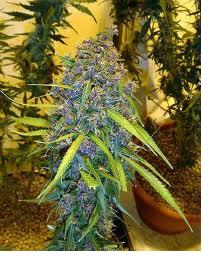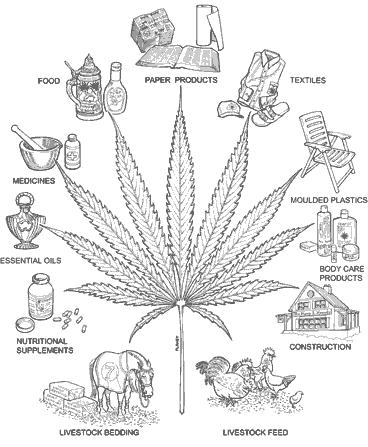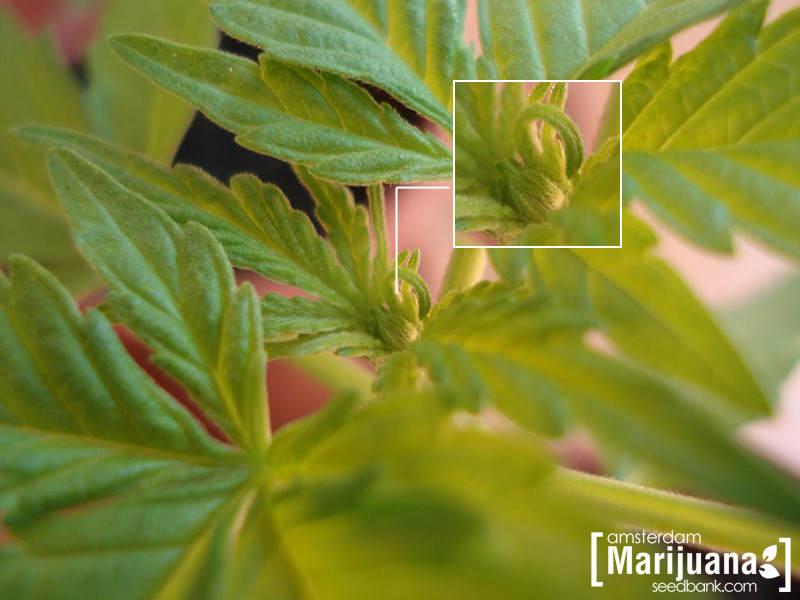|
Di seguito tutti gli interventi pubblicati sul sito, in ordine cronologico.
Nevertheless, the argument of its addictive potential remains.
In the US, marijuana is classified as a Schedule I substance, meaning that it must fulfill the requirement of having “a high potential for abuse”. But what exactly does this mean?

What is Drug Abuse?
Drug (or substance) abuse is defined as a pattern of drug use that occurs in amounts or by methods that are neither approved nor supervised by medical professionals.
Based on this definition, it is easy to see why marijuana may be considered as having a high potential for abuse, simply due to the fact that most medical professionals are unwilling to recommend or support its use. However, reasons for this lack of support are still unclear.
Since studies continue to show that marijuana poses little to no risk of long-term side effects, many are led to believe that marijuana must be dangerously addictive. But once again, scientific evidence suggests the contrary.
Addiction Potential
Studies estimate that only 1 in 10 individuals who try marijuana will ever become a regular user and display signs of dependence or addiction. Furthermore, health experts such as Dr. Jack E. Henningfield of the NIDA have ranked marijuana as the least addictive drug among substances such as caffeine, nicotine and alcohol.
Even still, marijuana addiction (also known as cannabis dependence) is a real medical condition that will affect a significant portion of users at some point in their lives.
What is Cannabis Dependence?
Cannabis dependence is a clinical condition that is classified according to DSM-IV guidelines. The DSM-IV is used by doctors in the United States and provides a standard criteria for the classification of mental conditions.
According to the DSM-IV, cannabis dependence is defined as:
A pattern of cannabis use that leads to 3 (or more) of the following symptoms:
1. Tolerance
2. Withdrawal
3. The substance is often taken in larger amounts or over a longer period than was intended
4. There is a persistent desire or unsuccessful efforts to cut down or control substance use
5. Large amounts of time are devoted to obtaining and using the substance and recovering from its effects
6. Important social, occupational or recreational activities are given up or reduced because of substance use
7. Continued use despite knowledge of having a persistent or recurrent physical or psychological problem that is likely to have been caused or exacerbated by the substance
Criteria adapted from the Diagnostic and Statistical Manual of Mental Disorders, Fourth Edition, Text Revision. Washington, DC, American Psychiatric Association, 2000 (DSM-IV-TR)
Tolerance and Withdrawal Symptoms
Some argue that marijuana differs from other substances in the sense that it is only ‘psychologically’ addictive – but this is not true.
While the psychological symptoms of addiction may be more prominent in cannabis users, studies show that cannabis dependence is accompanied by physical symptoms – such as tolerance and withdrawal – as well.
Tolerance occurs when increasing amounts of marijuana are necessary to achieve the desired effects. Tolerance is common among daily users and can be explained by the amount of time the body takes to metabolize cannabinoids such as THC.
Evidence suggests that THC can remain in the body for a significant amount of time, even after its effects have worn off. Furthermore, THC levels can build up in regular users and have been detected in blood samples taken after a month of no intake. When traces of THC are stored in the body over time, larger quantities of marijuana are necessary for users to achieve their desired ‘high’.
Withdrawal is another physical symptom of addiction that occurs when marijuana use is stopped after a period of regular use. Studies show that marijuana users are prone to a specific set of withdrawal symptoms, which include anxiety, irritability, physical tension, and decreases in mood. Once again, withdrawal is due to the build up of cannabinoid levels that occurs during regular use.
Research has found that withdrawal symptoms are most noticeable during the first 10 days of abstinence, but may be present for up to 28 days in some users. Overall, the symptoms and severity of withdrawal are expected to vary from user to user.
Source: truthonpot.com
This frightening belief was popularized in the 1970s when Ronald Reagan famously stated, “the most reliable scientific sources say permanent brain damage is one of the inevitable results of the use of marijuana.”

In the following years, Reagan’s scientific sources would be discredited and subsequent studies would be unable to replicate any evidence of brain damage, yet the myth remains as prominent today as it was 40 years ago.
False Monkey Study
Dr. Robert G. Heath was a researcher at Tulane University in New Orleans when he reported the findings of an experiment that apparently proved a connection between marijuana use and brain damage. Dr. Heath had conducted the study on rhesus monkeys by exposing them to an equivalent of 30 marijuana joints per day. After 90 days, the monkeys began to waste and die. When they were later autopsied, Dr. Heath reported significant brain damage in the monkeys that had been exposed to cannabis.
Despite strong support from the federal government, the study was heavily criticized for inaccurate procedures upon its release. Critics suggested that suffocation may have been the actual cause of brain damage instead of marijuana itself.
The findings were challenged and ultimately dismissed by a pair of larger, better-controlled studies – one by Dr. William Slikker of the National Center for Toxicological Research and the other by Charles Rebert and Gordon Pryor of SRI International – that attempted to replicate Dr. Heath’s results without success. The studies showed no change in the brain structure of monkeys that were given daily doses of marijuana for up to one year.
Human Studies
A number of studies have been conducted on human marijuana users over the past few decades, beginning in the 1970s as well.
In 1971, a study published by Campbell et al. involving 10 heavy users seemed to demonstrate a decrease in brain cells in a specific area of the brain, adding further to public concerns over marijuana use and brain damage. However, subsequent studies (Co et al., 1977, Hannerz and Hindmarsh, 1983 and Kuehnle et al., 1977) failed to replicate these findings, suggesting that the initial study was flawed yet again.
Recent research conducted on human subjects has also revealed conflicting evidence on marijuana use and brain damage. A study published in 2000 by researchers at the University of Iowa found no evidence of cerebral atrophy or regional volume differences in MRI scans of frequent cannabis users when compared to non-users.
On the other hand, the support for marijuana use causing brain damage seems to be stronger in studies that separate users by age. An early study conducted by Wilson et al. (2000) found that marijuana users who started using before the age of 17 seemed to exhibit noticeable changes in brain matter volume. However, the study found no differences in whole brain volumes overall.
In 2012, Duke University researchers published the results of a study that seemed to show that adolescents who started using marijuana before the age of 18 – and diagnosed as addicted by the time they were 38 – experienced a drop in IQ by early adulthood. The study suggested that heavy users could lose as much as 8 IQ points. However, an analysis published a few months later in the same medical journal determined that the findings of the previous study were once again plagued with inaccuracies and – using a statistical model to evaluate the original study’s data – seemed to show that there was no correlation between marijuana use and a drop in IQ.
Finally, studies that have investigated the effects of marijuana on brain cells have revealed findings that directly contrast with the popular belief of marijuana causing brain damage. In fact, a study published in 2005 showed that a synthetic form of THC could increase the growth of new brain cells – a process known as neurogenesis. CBD has also been found to have a similar effect on brain cell generation. Taken together, these findings seem to contradict the notion that marijuana may cause abnormal brain development in adolescent users.
Warning: Alcohol and Caffeine Can!
Most commonly abused substances – including alcohol and caffeine – can cause permanent brain damage so it may be a surprise to hear that marijuana is safe in this regard. Although users of marijuana may not be at risk of neurological damage, cannabis is still a psychoactive substance that subjects its user to a temporarily altered state of mind.
Source: truthonpot.com
Many also believe that the smoke from marijuana poses similar health risks as tobacco smoke, but is this a myth or reality?

Marijuana Vs. Tobacco
The smoke from burning marijuana leaves contains several known carcinogens, similar to those found in tobacco smoke. Worse, cannabis smoke also deposits a hefty amount of carcinogen-containing tar into the lungs – 4 times as much tar as an equivalent cigarette would due to the way marijuana joints are usually rolled (loosely packed and unfiltered).
On the other hand, the smoke from marijuana contains a set of very unique chemicals known as cannabinoids (eg. THC and CBD), which are not found in cigarette smoke. Numerous studies have found cannabinoids to possess potent anti-cancer and anti-tumor effects.
This key difference in the smoke produced by marijuana and that of cigarettes is suspected to play a major role in the different outcomes that marijuana and cigarettes have on the lungs.
What The Studies Show
Over the past decade, two large-scale studies have set out to identify the impact of heavy, sustained marijuana use on the lungs.
The first of these studies was led by Dr. Tashkin – a federal researcher and pulmonary specialist who has conducted over 30 years worth of research on marijuana and the lungs through generous grants from the National Institute on Drug Abuse (NIDA). In 2006, Tashkin co-authored a study involving over 2000 people which showed that, unlike tobacco, marijuana use did not increase the risk of lung cancer, even in subjects who reported smoking over 20,000 marijuana joints in their lifetime.
The second study was published in 2012 by a separate team of researchers from the University of California. It was the largest study ever to be conducted on marijuana smokers and involved a sample of over 5,000 adults. The researchers followed their subjects over a 20-year period and found that regular marijuana smoking – defined as a joint a day for 7 years or a joint a week for 20 years – had no impact on lung function. On the contrary, the results suggested a slight improvement in lung function for regular smokers of marijuana.
Both studies also included a sample of tobacco smokers for comparison and both were able to confirm what we already know – cigarette smoking is directly correlated with lung disease and impaired lung function.
What’s The Explanation?
So what is it about marijuana smoke that makes its impact on lungs so drastically different from cigarettes that even professional athletes are willing to partake in the occasional puff?
Although many experts seem baffled at the results of the two studies mentioned above, Dr. Tashkin believes he may have an explanation. He speculates that the THC molecules in marijuana may be protective of lung cancer by influencing aged cells to die before they can become cancerous.
“We hypothesized that there would be a positive association between marijuana use and lung cancer, and that the association would be more positive with heavier use. What we found instead was no association at all, and even a suggestion of some protective effect.” – Dr. Tashkin
This theory is well supported by the abundance of evidence that demonstrates THC’s strong anti-tumoral and other anti-cancer effects, even specifically in the case of lung cancer.
Other Risks of Marijuana Smoke
Although marijuana smokers may have little to worry about lung cancer or decreased lung function, studies show that marijuana users are still at risk of a disease known as chronic bronchitis.
Chronic bronchitis is characterized by inflammation of the airway, resulting in the following 2 symptoms:
• Persistent cough (a cough that won’t go away)
• Extra mucus (phlegm) production
Studies show that patients without noticeable impairment of lung function can still be suffering from symptoms of chronic bronchitis.
Unfortunately, there is no method of effective treatment for chronic bronchitis caused by smoking. The best method of prevention and treatment is to simply stop smoking – even just for a temporary period of time.
Vaporizing: Is It Safer?
If you suspect you may be suffering from chronic bronchitis but stopping marijuana use is not an option, investing in a vaporizer may be your best bet. A study published in 2010 showed that marijuana smokers who switched to using a vaporizer experienced benefits in lung health that were comparable to quitting cigarettes.
Health professionals recommend the use of vaporizers for all patients who use medical marijuana. Vaporizers allow the plant matter to be heated to a temperature high enough for cannabinoids to be released as a vapor but low enough to avoid the combustion and release of the harmful by-products normally found in marijuana smoke.
By using a vaporizer, the risk of airway inflammation associated with marijuana smoke may be avoided.
Source: truthonpot.com
In fact, early humans depended on hemp plants in order to fulfill an array of basic necessities such as clothes, food, fabrics, rope, paper and more. Even today, hemp is grown and cultivated in over 30 countries for much of the same uses that early human civilizations relied on the hemp plant for.

Cannabis sativa
The term ‘hemp’ refers to distinct strains of the Cannabis sativa plant that contain low levels of THC – usually less than 0.3%. Of the 2000 known varieties of cannabis plants, approximately 90% contain trace levels of THC and are useful only for their hemp seeds and fibers. The minimal levels of THC render hemp plants useless for the psychoactive and recreational purposes that cannabis plants are commonly associated with.
Hemp is highly regarded as an agricultural crop for a number of reasons. In addition to its wide range of applications from food to clothes, hemp is one of the fastest growing biomasses known – capable of producing up to 25 tonnes of dry matter per hectare per year. Hemp plants are also environmentally friendly, requiring no herbicides and few pesticides. As well, hemp is a very robust crop and can be grown in diverse soil and climate conditions.
The History of Hemp
Archaeological evidence of hemp use dates back to the Neolithic Age in China, where imprints of hemp fiber were discovered on Yangshao culture pottery from the 5th century B.C. Ancient Chinese civilizations would later use hemp to make clothes, shoes, ropes and an early form of paper.
Eventually, the use of hemp spread to other parts of the developing world. In the Princeton University Press publication entitled Prehistoric Textiles (1992), textile expert Elizabeth Wayland Barber summarizes the historical evidence that Cannabis sativa, “grew and was known in the Neolithic period all across the northern latitudes, from Europe (Germany, Switzerland, Austria, Romania, the Ukraine) to East Asia (Tibet and China),” but, “textile use of Cannabis sativa does not surface for certain in the West until relatively late, namely the Iron Age.”
Hemp was grown and cultivated in Europe mainly for its fibers, and was used for ropes on many ships, including those of Christopher Columbus. The famous explorer was known to carry hempseed on his ships in case of shipwreck, in order to grow raw materials and for use as a food source.
Early settlers in North America brought hemp with them and must-grow laws were eventually enacted that forced all farmers to grow the crop. In fact, the first laws in America to ever address the cannabis plant was a must-grow law enacted in 1619, which forced all settlers in Jamestown Colony, Virginia to grow the plant, since it was such an essential agricultural crop at the time. Similar laws were put in place over the next 200 years, during which time hemp even became a legal tender crop.
Hemp in the US
Hemp was highly regarded by many historic Americans of the time. George Washington grew hemp at Mount Vernon as one of his three primary crops and Benjamin Franklin started one of the first American paper mills by making paper exclusively out of cannabis hemp. Domestic production of hemp flourished until sometime after the Civil War when it began to be replaced by the production of newer materials that were less labor intensive, such as cotton.
The hemp crop received renewed interest during World War II following the 1942 production of a short film entitled Hemp for Victory, which promoted hemp as a necessary crop to win the war. Hemp was used extensively during the war to create textiles such as uniforms, canvas and rope.
Modern Day Uses
Hemp is grown in countries all over the world and is used for a wide array of industrial purposes, including paper, textiles, clothing, biodegradable plastics, construction, body products, health food and bio-fuel.
In 1938, Popular Mechanics Magazine published an article about hemp entitled The New Billion Dollar Crop, which described the usefulness of hemp in producing over 25,000 different products, ranging from dynamite to cellophane. Oddly enough, free production of hemp had already been made illegal a year earlier through the Marijuana Tax Act of 1937.
To this day, hemp remains illegal to grow under U.S. federal law, due to its inherent similarity to the marijuana plant. However, U.S. retailers and manufacturers import approximately 1.9 million pounds of hemp fiber, 450,000 pounds of hemp seeds, and 331 pounds of hempseed oil annually from Canada and other countries that regulate the farming of hemp.
Source: truthonpot.com
You should watch this video. Do it.

The song at the end is "All About Me" by Dusty Smith.


I've been getting a lot of condescending messages from "Agnostics" lately attempting to belittle me for being an atheist, but the joke is on you suckers, because you're basically just belittling yourselves.
These two species of cannabis are widely cultivated around the world for various recreational and medicinal purposes.

Marijuana and Cannabinoids
The distinct shape of the Cannabis leaf (pictured) is recognized around the world
Marijuana elicits a number of psychoactive and physiological effects on its user, all of which can be attributed to a group of chemicals known as cannabinoids.
The cannabinoids found in plants are sometimes referred to as phytocannabinoids (‘phyto’ = plant) and the female cannabis plant is known to produce over 60 unique cannabinoids when flowering. These flowers (or buds) are the only part of the plant that contain a high concentration of cannabinoids and are generally the only part that is cultivated for use.
Among these cannabinoids are two major constituents of marijuana – tetrahydrocannabinol (THC) and cannabidiol (CBD) – both of which have been thoroughly studied. THC has been the most popularized phytocannabinoid due to its well-known psychoactive effects, which have been attributed to the “high” that marijuana users experience.
Marijuana Intake
Cannabinoids must enter the blood stream to elicit their effects within the human body.
The most common method of intake is by smoking, as the cannabinoids in marijuana can only be released under certain conditions such as high temperatures. When marijuana smoke is inhaled, cannabinoids cross from the lungs to the blood stream within a matter of seconds. Once in the blood stream, cannabinoids enter circulation and begin to elicit their effects by binding to receptors found in various parts of the body.
Marijuana can also be prepared for ingestion, which results in a weaker but longer release of cannabinoids as absorption occurs in the stomach instead of the lungs.
Cannabinoid Receptors (CB1 and CB2)
There are two types of receptors in the human body that cannabinoids can bind to: CB1 and CB2. These receptors exist as part of the endocannabinoid system – the body’s natural cannabinoid system – that includes naturally occurring cannabinoids (endocannabinoids) such as anandamide and 2-arachidonoylglycerol (2-AG).
Phytocannabinoids – such as THC and CBD – are able to mimic the actions of endocannabinoids within the body by binding to the same receptors as they do.
THC has a higher affinity for CB1 receptors, which are most prominent in the brain and spinal cord but are also found in peripheral systems and organs such as the liver, GI tract, and thyroid glands. CB2 receptors are expressed almost exclusively in the immune system but have recently been identified in other parts of the body as well.
Source: truthonpot.com
The study was published in the Cambridge Journals and it can be found here.

During the study researchers examined the effect of CBD on the hippocampus part of the brain; the hippocampus is a portion of the brain which plays a key role in regulating emotion and memory – it’s the only part of the brain that can grow after someone is an adult.

According to researchers, this study (and those like it) opens the door for cannabidiol being used to “manage psychiatric symptoms in disorders such as ageing, stress and neuroinflammation.”

This study is one of the most comprehensive of its type, and confirms a past study from 2005 that found similar results (which can be found in its entirety by clicking here).
Source: TheJointBlog.com via TheWeedBlog.com
It’s been quickly retweeted dozens of times, indicating that the idea is interesting to many people. So let’s discuss it in more than 140 characters.

In case it needs saying: Police officers are unlike terrorists in almost all respects. Crucially, the goal of the former, in their vastest majority, is to have a stable, peaceful, safe, law-abiding society, which is a goal we all share. The goal of the latter is … well, it’s complicated. I’ve cited my favorite expert on that, Audrey Kurth Cronin, here and here and here. Needless to say, the goal of terrorists is not that peaceful, safe, stable society.
I picked up the statistic from a blog post called: “Fear of Terror Makes People Stupid,” which in turn cites the National Safety Council for this and lots of other numbers reflecting likelihoods of dying from various causes. So dispute the number(s) with them, if you care to.

I take it as a given that your mileage may vary. If you dwell in the suburbs or a rural area, and especially if you’re wealthy, white, and well-spoken, your likelihood of death from these two sources probably converges somewhat (at very close to zero).
The point of the quote is to focus people on sources of mortality society-wide, because this focus can guide public policy efforts at reducing death. (Thus, the number is not a product of the base rate fallacy.) In my opinion, too many people are still transfixed by terrorism despite the collapse of Al-Qaeda over the last decade and the quite manageable — indeed, the quite well-managed — danger that terrorism presents our society today.
If you want to indulge your fears and prioritize terrorism, you’ll have plenty of help, and neither this blog post nor any other appeal to reason or statistics is likely to convince you. Among the John Mueller articles I would recommend, though, is “Witches, Communists, and Terrorists: Evaluating the Risks and Tallying the Costs” (with Mark Stewart).
If one wants to be clinical about what things reduce death to Americans, one should ask why police officers are such a significant source of danger. I have some ideas.
Cato’s work on the War on Drugs shows how it produces danger to the public and law enforcement both, not to mention loss of privacy and civil liberties, disrespect for law enforcement, disregard of the rule of law, and so on. Is the sum total of mortality and morbidity reduced or increased by the War on Drugs? I don’t know to say. But the War on Drugs certainly increases the danger to innocent people (including law enforcement personnel), where drug legalization would allow harm to naturally concentrate on the people who choose unwisely to use drugs.
The militarization of law enforcement probably contributes to the danger. Cato’s Botched Paramilitary Police Raids map illustrates the problem of over-aggressive policing. Cato alum Radley Balko now documents these issues at the Huffington Post. Try out his “Cop or Soldier?” quiz.
There are some bad apples in the police officer barrel. Given the power that law enforcement personnel have — up to and including the power to kill—I’m not satisfied that standards of professionalism are up to snuff. You can follow the Cato Institute’s National Police Misconduct Reporting Project on Twitter at @NPMRP.
If the provocative statistic cited above got your attention, that’s good. If it adds a little more to your efforts at producing a safe, stable, peaceful, and free society, all the better.
This article originally appeared on the Cato@Liberty blog. Source: policymic.com
If you look closely, you may just find the name of one listed among the names of more than 800 scientists from around the globe who have joined forces in an open letter to all world governments, outlining their detailed concerns over the alarming potential threat of biotech’s unauthorized, worldwide GMO foods experiment.

In a country whose government and media appear only too eager to conjure up fear of “bioterrorism” and “biological weapons,” it’s shocking (albeit obviously deliberate) to what extent the GMO issue remains omitted from mainstream discussion. Consider that the message from these scientists seems to be that the whole planet is already under attack by the persistent and largely unchecked, reckless behavior of greedy, unruly U.S. corporations – corporations whose activities appear to be sponsored by the federal government. And whether you know it yet or not, your body is the battleground.
The letter, as posted by the Institute of Science in Society, is a collective call for the immediate suspension of any and all releases of GM crops and products into the environment for at least five years, in order to allow for more thorough testing. The scientists further demand that all patents on life-forms and living processes – including seeds, cell lines and genes – be revoked and banned “for a comprehensive public inquiry into the future of agriculture and food security for all.”

Life is a discovery, they say, not an innovation, and patents on life-forms and living processes “sanction biopiracy of indigenous knowledge and genetic resources, violate basic human rights and dignity, compromise healthcare, impede medical and scientific research and are against the welfare of animals.” Furthermore, they argue that GM crops provide no identifiable benefits either to farmers or consumers; instead, they offer only very significant risks to all living things.
GMOs are just bad news, followed by more bad news
Any consumption of GMO products is basically a smorgasbord of disaster, say these global scientists. In their thorough and fully cited open letter, they take biotechnology to task – making clear, undeniable connections between GM food crops and other products (like milk from cows injected with genetically modified Bovine Growth Hormone) and health problems for mammals in general. At the same time the GM crops themselves actually contribute to lower yields, increased use of herbicides/insecticides, unpredictable performance, poor economic returns, and a progressive monopoly on food by big corporations, they also encourage herbicide-tolerant weeds and pesticide-resistant superbugs, making their purported goal of “feeding the world” appear just as it is – clearly out of the reach of biotech industry. Scientists propose, instead, that these large food corporations are actually more the cause of world hunger currently, than they are the solution to it.
“It is on account of increasing corporate monopoly operating under the globalised economy that the poor are getting poorer and hungrier,” scientists say. “Family farmers around the world have been driven to destitution and suicide… Mergers and acquisitions are continuing.” Seed patent policies currently in place at biotech companies prevent farmers from saving and replanting seeds, an activity the scientists acknowledge, is one enjoyed even by third world farmers.
As promised; however, it only gets worse. Scientists agree that GMOs actually harm the delicate biodiversity necessary to the balance and maintenance of life on this planet. GM products, they say, “decimate wild plant species indiscriminately,” cause birth defects in mammals, kill insects essential to pollination like bees, lacewings, monarch butterflies, and pose other very serious threats related to horizontal gene transfer – for example, the “spread of antibiotic resistance marker genes that would render infections diseases untreatable, the generation of new viruses and bacteria that cause diseases, and harmful mutations which may lead to cancer.”
Multiple hazards to both animal and human health have already been identified by sources around the world, resulting either in bans on GM products or the adoption of strict labeling laws by many countries. Here in the U.S.; however, secret memoranda from inside the FDA have revealed its history of disregarding the warnings of its own scientists. Still, with a separate but similar mass appeal to the United Nations Food and Agriculture Organization in 2009 failing to make a rippled, lasting impact, one can only hope that eventually the science on GMOs – and the growing number of people who know about it – will simply be too loud to ignore.
Author: Summer Tierney - Source: NaturalNews.com via undergroundhealth.com
Dave Schuit, un apicoltore di Elmwood ha perso 600 alveari. Egli punta il dito contro gli insetticidi noti come neonicotinoidi, che sono prodotti dalla Bayer CropScience Inc. Questo è avvenuto anche dopo un recente rapporto pubblicato dalla Associazione Apicoltori Britannici (BBKA), che ha riportato la più grande perdita di api mai registrata. L’Unione europea ha fatto un passo in avanti, dopo aver bandito diversi pesticidi che sono stati collegati alla morte di milioni di api.
La moria di api è avvenuta dopo la semina del mais. I pesticidi neonicotinoidi sono usati per rivestire i semi di mais con seminatrici pneumatiche. Ciò provoca il diffondersi della polvere del pesticida soffiato quando avviene la semina. La morte di milioni di impollinatori è stata studiata dalla Purdue University. Hanno scoperto che le api hanno mostrato sintomi neurotossici. Hanno analizzato api morte e hanno scoperto che le tracce di thiamethoxam/clothiandin erano presenti in ogni singolo caso. L’unica fonte principale di questi composti sono i trattamenti delle sementi di colture di campo.

Le morie di api sono in aumento esponenziale. Un team internazionale di scienziati guidati dll’ Università di Utrecht dell’Olanda ha concluso che “su larga scala l’uso del prophylaxic in agricoltura, la sua elevata persistenza nel suolo e nell’acqua, il suo assorbimento da parte delle piante e la diffusione attraverso i pollini, mette a rischio la vita degli insetti impollinatori”.

E’ necessaria un’immediata inversione di marcia. Api ed insetti indispensabili per il loro prezioso lavoro di impollinatori continuano a morire e con loro muore anche la natura intera che si rigenera e riproduce anche grazie al loro lavoro.
Questo è solo l’ultimo episodio, purtroppo ci sono tanti, troppi precedenti, Inoltre le sostanze chimiche utilizzate in agricoltura non sono nocive solo per gli insetti e le api ma anche e sopratutto per gli esseri umani.
Fonte: laviadiuscita.net
|